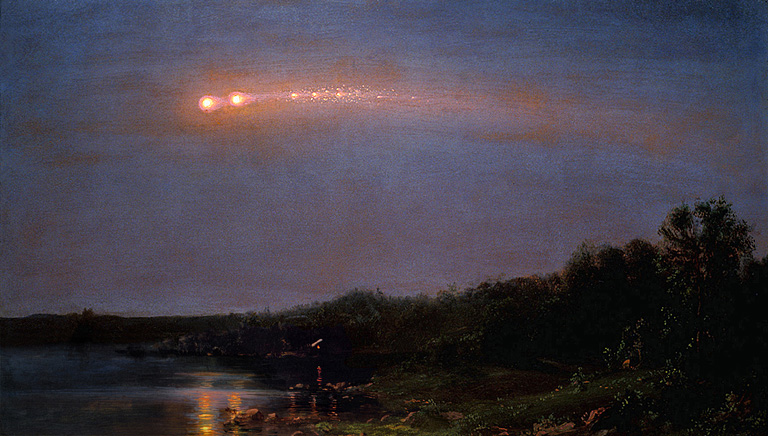"The rare event described in the poem 'Year of Meteors (1859-1860)' is indeed called a 'meteor procession.' It takes place when a grazer meteor breaks up and the pieces travel together as if in formation.
Scholars have for decades tried to identify a puzzling celestial event in one of Walt Whitman's poems from his collection "Leaves of Grass." Now they've done so — using clues from a famed American landscape painting.
In the July issue of Sky and Telescope magazine, a team that includes astronomers and a literary scholar, all from Texas State University, details the existence and nature of the rare event, in which meteor fragments crossed the sky in stately, synchronized fashion.
The heavenly display is described in the poem "Year of Meteors (1859-1860)," in which Whitman writes of the tumultuous period leading up to the Civil War. He touches upon the hanging of abolitionist John Brown and the ascendancy of Abraham Lincoln to the presidency, and he makes two references to astronomy: "The comet that came unannounced out of the north, flaring in heaven," and "the strange huge meteor procession, dazzling and clear, shooting over our heads."
Identifying the comet in the verses was easy, said astronomer Don Olson, lead author of the article. It had to be the Great Comet of 1860, seen in the Northern Hemisphere on June 18 of that year.
Identifying the second event, what Whitman called the "meteor procession," proved much more difficult.
"Various authors have tried to figure out what Whitman was describing. This thing has been bubbling in my mind [since] 1994," said Olson, who that year started teaching a class on astronomy in art, history and literature.
Prevailing theories didn't make sense to Olson. Some scholars had thought that the poem could have been referring to an 1859 daylight fireball — but Whitman has the meteor occurring at night, and describes several flares traveling through the sky at once.
Others thought the poet may have been recalling the 1833 Leonid meteor shower, which Whitman did indeed witness — but that is inconsistent with the poem's timeframe (1859-1860) and doesn't match the description. Whitman's procession lasted "a moment, a moment long," but meteor showers last for hours, even days.
The breakthrough came in 2000, when Olson picked up a catalog of works by 19th-century landscape artist Frederic Edwin Church.
"Scientists in general, but astronomers in particular, love Frederic Church because he was such a careful observer of the sky," Olson said. "You can see it in his paintings."
Olson turned the catalog over. On the back was a copy of the painting "The Meteor of 1860."
The scene clearly depicts two large balls of light passing almost horizontally across the night sky, followed by a series of smaller fragments.
The astronomer recognized this as an extremely rare event that is in fact called a "meteor procession," in which a meteor breaks up and the pieces travel together as if in formation before exiting the Earth's atmosphere once more.
A procession is rare, Olson said, because so many factors need to fall into place. The meteor, known as a grazer, must travel almost tangent to the Earth's surface, giving it a long, near-horizontal path across the skies. It usually has to travel between about 35 and 40 miles above the ground — any higher and it would not light up, any lower and it would likely fall to Earth. And it has to break up very soon after entering the Earth's atmosphere, or the procession-like effect will be lost."
You can look up Walt Whitman's poem titled "Year of Meteors" and read it for yourself. Notice that he mentioned a comet as well. The landscape painter Edwin Church painted a picture titled "Meteor of 1860" seen below.
Now back to the solar storm of 1859. The following information is from NASA Science.
"The magnetic fields contained within it were extremely intense and in direct opposition with Earth's magnetic fields. That meant the coronal mass ejection of September 1, 1859, overwhelmed Earth's own magnetic field, allowing charged particles to penetrate into Earth's upper atmosphere. The endgame to such a stellar event is one heck of a light show and more -- including potential disruptions of electrical grids and communications systems.
Back in 1859 the invention of the telegraph was only 15 years old and society's electrical framework was truly in its infancy. A 1994 solar storm caused major malfunctions to two communications satellites, disrupting newspaper, network television and nationwide radio service throughout Canada. Other storms have affected systems ranging from cell phone service and TV signals to GPS systems and electrical power grids. In March 1989, a solar storm much less intense than the perfect space storm of 1859 caused the Hydro-Quebec (Canada) power grid to go down for over nine hours, and the resulting damages and loss in revenue were estimated to be in the hundreds of millions of dollars.
"The question I get asked most often is, 'Could a perfect space storm happen again, and when?'" added Tsurutani. "I tell people it could, and it could very well be even more intense than what transpired in 1859. As for when, we simply do not know," he said."
The solar storm of 1859 caused the aurora borealis to be seen as far south as Cuba and in some places further to the north you could even stand outside in the nightime and read the newspaper by the light. If it happened again (and it will) it would devastate our whole infrastructure. Everything would shutdown. The military has adequate shielding, but virtually everything else would cease to work.
I wonder if there is a connection in all of these events. I don't know, Scientists say there isn't. I just don't know. I do know that big solar storms are predicted next year by NASA and other scientists. I do know there is a comet headed this way. I can only wonder what if any connection there might be.
YBIC
Bruce Baber
